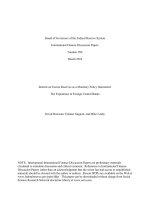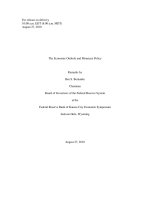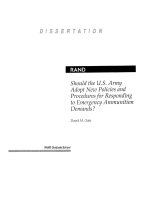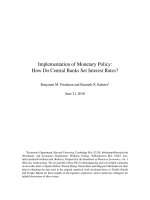what should central banks do monetary policy goals, strategy and tactics
Bạn đang xem bản rút gọn của tài liệu. Xem và tải ngay bản đầy đủ của tài liệu tại đây (479.66 KB, 30 trang )
Copyright 2011
Pearson Canada Inc.
18 -
1
Chapter 18
What Should Central Banks Do?
Monetary Policy Goals, Strategy
and Tactics
Copyright 2011
Pearson Canada Inc.
18 -
2
Monetary Targeting Strategy
•
Central bank announces it will achieve a
certain value (the target) of the annual growth
rate of a monetary aggregate.
•
Central bank then is accountable for hitting the
target
•
Monetary targeting was adopted by several
countries: Germany, Switzerland, Canada, the
U.K., Japan and the U.S.
Copyright 2011
Pearson Canada Inc.
18 -
3
Monetary Targeting
•
Flexible, transparent, accountable
•
Advantages
–
Almost immediate signals help fix inflation expectations
and produce less inflation
–
Almost immediate accountability
•
Disadvantages
–
Must be a strong and reliable relationship between the
goal variable and the targeted monetary aggregate
Copyright 2011
Pearson Canada Inc.
18 -
4
Inflation Targeting
•
Public announcement of medium-term numerical
target for inflation
•
Institutional commitment to price stability as the
primary, long-run goal of monetary policy and a
commitment to achieve the inflation goal
•
Information-inclusive approach in which many
variables are used in making decisions
•
Increased transparency of the strategy
•
Increased accountability of the central bank
Copyright 2011
Pearson Canada Inc.
18 -
5
Inflation Targeting in New Zealand
•
Reserve Bank of New Zealand Act 1989
•
Minster of Finance and Governor of Reserve Bank to
make Policy Targets Agreement
•
Governor of the Reserve Bank was held accountable
for the success of monetary policy.
•
Inflation brought down from above 5% to below 2%
by the end of 1992
•
Since 1992 NZ growth rate has been high and
unemployment declined significantly
Copyright 2011
Pearson Canada Inc.
18 -
6
Inflation Targeting In Canada
•
In 1991, the Minister of Finance and the Governor of the
Bank of Canada established formal inflation targets
•
The target range was 2-4% by the end of 1992, 1.5-3%
by June 1994 and 1-3% by December 1996
•
After a new government took office in 1993, the target
was set at 1-3% and has been kept at this level ever
since
•
Canadian inflation has fallen dramatically since the
adoption of targets, falling from 5% in 1991, to zero in
1995 and between 1-2% in the late 1990’s
Copyright 2011
Pearson Canada Inc.
18 -
7
Inflation Targeting in the U.K.
•
Adopted inflation target as nominal anchor in
October 1992
•
Inflation target was initially set at 1-4%
•
May 1997 inflation target set at 2.5% and Bank of
England was given power to set interest rates
(provided independence)
•
December 2003, target was changed to 2%.
•
Growth in U.K. economy has been strong leading to
reduction in the unemployment rate
Copyright 2011
Pearson Canada Inc.
18 -
8
Inflation Rates and Inflation Targets
Figure 18-1(a)
Copyright 2011
Pearson Canada Inc.
18 -
9
Inflation Rates and Inflation Targets
Figure 18-1(b)
Copyright 2011
Pearson Canada Inc.
18 -
10
Inflation Rates and Inflation Targets
Figure 18-1(c)
Copyright 2011
Pearson Canada Inc.
18 -
11
Inflation Targeting
•
Advantages
–
Does not rely on one variable to achieve target
–
Easily understood
–
Reduces potential of falling in
time-inconsistency trap
–
Stresses transparency and accountability
•
Disadvantages
–
Delayed signaling
–
Too much rigidity
–
Potential for increased output fluctuations
–
Low economic growth
Copyright 2011
Pearson Canada Inc.
18 -
12
Monetary Implicit Nominal Anchor
•
U.S. does not use explicit nominal anchor.
•
Involves forward looking behaviour , careful
monitoring for signs of future inflation coupled
with periodic “pre-emptive strikes” by
monetary policy against threat of inflation
•
Monetary policy has long lags
•
Cannot wait to respond until inflation has
begun.
•
Needs to be forward-looking and pre-emptive
Copyright 2011
Pearson Canada Inc.
18 -
13
Advantages and Disadvantages to the U.S
Approach
•
Does not rely on a stable money-inflation
relationship
•
Discourages overly expansionary monetary policy
•
Lack of transparency
•
Uncertainty leads to unnecessary volatility in
financial markets, doubt among producers/general
public
•
Strong dependence on the preferences, skills and
trustworthiness of the central bank staff
Copyright 2011
Pearson Canada Inc.
18 -
14
Summary of Advantages and Disadvantages of
Different Monetary Policy Strategies
Copyright 2011
Pearson Canada Inc.
18 -
15
Tactics: Choosing the Policy Instrument
•
Tools
–
Open market operation
–
Government deposit shifting
–
Last resort lending
–
Overnight interest rate
•
Policy instrument (operating instrument)
–
Reserve aggregates
–
Interest rates
–
May be linked to an intermediate target
•
Interest-rate and aggregate targets
are incompatible
Copyright 2011
Pearson Canada Inc.
18 -
16
Linkages Between Central Bank Tools, Policy
Instruments, Intermediate Targets and Goals
Copyright 2011
Pearson Canada Inc.
18 -
17
The Price Stability Goal
•
Low and stable inflation
•
Inflation
–
Creates uncertainty and difficulty in planning for
future
–
Lowers economic growth
–
Strains social fabric
•
Nominal anchor
•
Time-inconsistency problem
Copyright 2011
Pearson Canada Inc.
18 -
18
Result of Targeting Non-borrowed Reserves
Copyright 2011
Pearson Canada Inc.
18 -
19
Result of Targeting Overnight Funds
Copyright 2011
Pearson Canada Inc.
18 -
20
Criteria for Choosing the Policy Instrument
•
Observability and Measurability
•
Controllability
•
Predictable effect on Goals
Copyright 2011
Pearson Canada Inc.
18 -
21
The Taylor Rule, NAIRU, and the Phillips
Curve
Overnight interest rate = inflation rate + equilibrium
overnight rate + ½ (inflation gap) + ½ (output gap)
•
An inflation gap and an output gap
–
Stabilizing real output is an important concern
–
Output gap is an indicator of future inflation as shown by
Phillips curve
•
NAIRU
–
Rate of unemployment at which there is no tendency for
inflation to change
Copyright 2011
Pearson Canada Inc.
18 -
22
Taylor Rule and the Overnight Interest Rate
Copyright 2011
Pearson Canada Inc.
18 -
23
Central Bank’s Response to Asset-Price
Bubbles
•
Two Types of Asset-Price Bubbles
–
Credit-Driven Bubbles
–
Bubbles Driven by Irrational Exuberance
•
Central Banks Response to Bubbles
•
Monetary Policy and Asset-Price Bubbles
•
Other Appropriate Policy Responses
–
Macroprudential regulation
Copyright 2011
Pearson Canada Inc.
18 -
24
Bank of Canada Historical Perspective: The
Early Years
•
Bretton Wood (1945-1970s)
•
1971 flexible exchange rate with the U.S
•
Expansionary MP in 1970s lead to high inflation
•
Rise of monetarism
•
CB adopted key monetary aggregates as
intermediate targets of monetary policy
Copyright 2011
Pearson Canada Inc.
18 -
25
Interest Rates - Canada and U.S., 1941-2009









